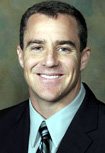Sports Injury Expert Receives Grant to Study Latest ACL Reconstruction Methods

Brian Feeley
UCSF orthopedic surgeon and sports injury specialist Brian Feeley, MD, has received a $40,000 grant to evaluate techniques for treating an increasingly common knee injury in children.
The award, the 2009 Young Investigators Grant, comes from the American Orthopaedic Society for Sports Medicine (AOSSM) and is specifically designed to support young researchers who have not received prior funding, the organization said.
Feeley, an assistant professor in residence in the UCSF Department of Orthopaedic Surgery, is an expert in the treatment of pediatric sports injuries and athletic injuries in general.
With youth participation in sports skyrocketing, and with extracurricular leagues and summer camps enabling young athletes to play year-round, there is a corresponding increase in the number of sports-related injuries, Feeley said.
Knee injuries, particularly tears in the anterior cruciate ligament (ACL), are quite common among athletes. ACL injuries weaken the knee’s overall stability and can make the sudden, pivoting movements that most athletes rely on quite difficult.
Often, individuals with ACL injuries must undergo reconstructive surgery in which the torn ligament is removed and a new ACL is constructed using other, healthy tissue. Conventional surgical reconstruction techniques, however, risk interfering with a young, skeletally immature patient’s growth, Feeley said.
“Successful pediatric ACL reconstruction would allow patients to grow in the way they are intended to grow, while also allowing as stable a knee as possible,” he said.
With the AOSSM grant, Feeley and his colleagues will use computer-assisted navigation to test three different ACL reconstruction techniques and evaluate how well they contribute to both rotational and static stability of the knee.
One reconstruction technique aims to prevent growth disturbances by completely avoiding the growth plate within the knee. Another takes a graft from the iliotibial band the thick band of fibrous tissue that runs along the outside of the leg and wraps it around the thighbone and down through the front of the knee. The third technique involves drilling through the shinbone and then going around the back of the thighbone to attach the graft.
“What we don’t know yet is how biomechanically functional these grafts are,” Feeley said of the experimental surgical methods. “Does the knee act normally or close to normally after reconstruction?”
Feeley will receive $5,000 every three months for the next two years from the AOSSM, and will collaborate with other on-campus experts, including Jeff Lotz, PhD, director of UCSF’s Orthopaedic Surgery Bioengineering Research Lab.
Founded in 1972, AOSSM is a national organization of orthopedic surgeons dedicated to sports medicine.